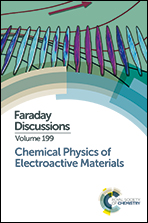Field induced anomalous spreading, oscillation, ejection, spinning, and breaking of oil droplets on a strongly slipping water surface†
Abstract
Application of an electric field on an oil droplet floating on the surface of a deionized water bath showed interesting motions such as spreading, oscillation, and ejection. The electric field was generated by connecting a pointed platinum cathode at the top of the oil droplet and a copper anode coated with polymer at the bottom of the water layer. The experimental setup mimicked a conventional electrowetting setup with the exception that the oil was spread on a soft and deformable water isolator. While at relatively lower field intensities we observed spreading of the droplet, at intermediate field intensities the droplet oscillated around the platinum cathode, before ejecting out at a speed as high as ∼5 body lengths per second at even stronger field intensities. The experiments suggested that when the electric field was ramped up abruptly to a particular voltage, any of the spreading, oscillation, or ejection motions of the droplet could be engendered at lower, intermediate and higher field intensities, respectively. However, when the field was ramped up progressively by increasing by a definite amount of voltage per unit time, all three aforementioned motions could be generated simultaneously with the increase in the field intensity. Interestingly, when the aforementioned setup was placed on a magnet, the droplet showed a rotational motion under the influence of the Lorentz force, which was generated because of the coupling of the weak leakage current with the externally applied magnetic field. The spreading, oscillation, ejection, and rotation of the droplet were found to be functions of the oil–water interfacial tension, viscosity, and size of the oil droplet. We developed simple theoretical models to explain the experimental results obtained. Importantly, rotating at a higher speed broke the droplet into a number of smaller ones, owing to the combined influence of the spreading due to the centripetal force and the shear at the oil–water interface. While the oscillatory and rotational motions of the incompressible droplet could be employed as stirrers or impellers inside microfluidic devices for mixing applications, the droplet ejection could be employed for futuristic applications such as payload transport or drug delivery.
- This article is part of the themed collection: Chemical Physics of Electroactive Materials


 Please wait while we load your content...
Please wait while we load your content...